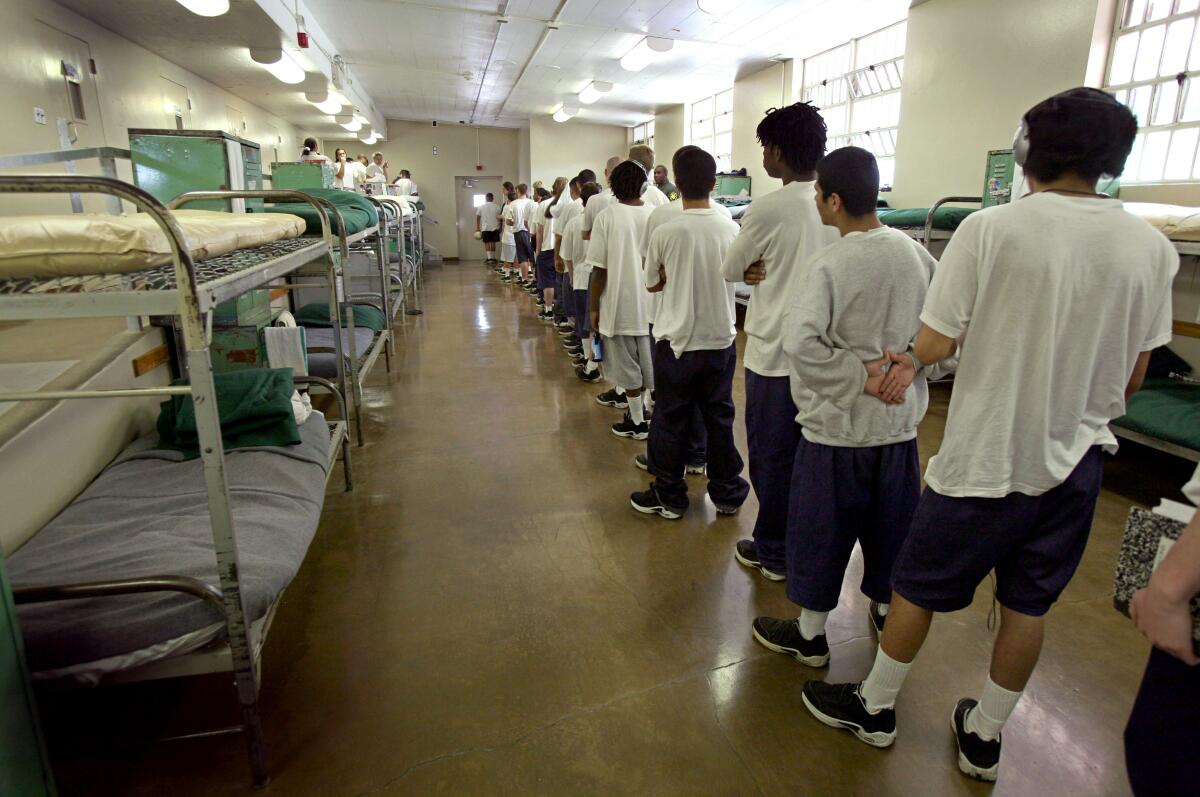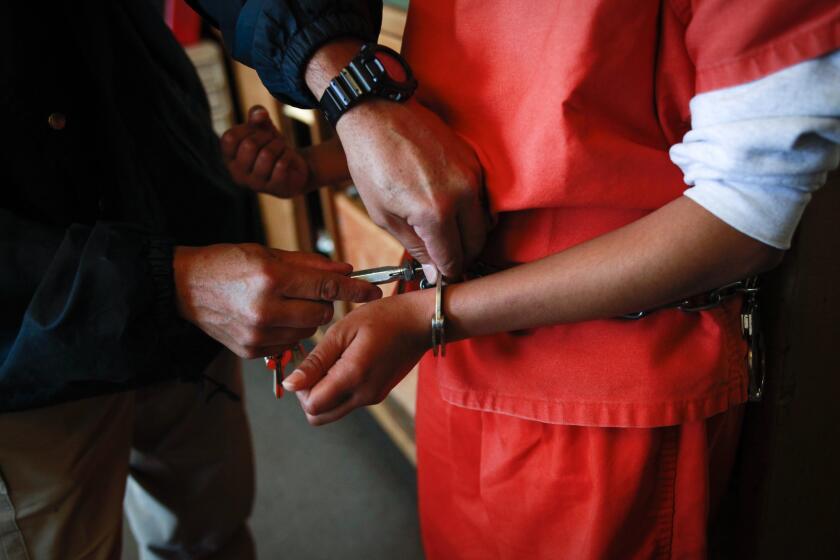California plans to close troubled youth prisons after 80 years. But what comes next?

- Share via
Eighty years after California created separate incarceration facilities to spare teenagers from being locked up alongside adults, the state has pledged to begin the shutdown of its long-troubled and frequently violent youth prisons.
The planned dismantling of the Division of Juvenile Justice, or DJJ, comes after years of scandal and mistreatment of young offenders, which spurred multiple reform efforts and more than a decade of state court oversight that ended in 2016. The shutdown mirrors changes across the country — embracing rehabilitation over punishment and confinement close to home, rather than in isolated state facilities.
Three remaining DJJ prisons will stop taking new prisoners in July, with rare exceptions. California plans to close the facilities — twin lockups in Stockton and another in Ventura — in July 2023, under a state law passed last year and a budget directive issued in January by Gov. Gavin Newsom.
Longtime critics of the youth prisons called the pending closure “a transformational event,” coming just two decades after California voters passed Proposition 21, intended to get tough on young offenders by sending many to adult prisons.
As recently as 2019, the Center on Juvenile and Criminal Justice, a nonprofit group supportive of dismantling the state youth facilities, said in a scathing report that DJJ staff “abet violence, reinforce racial and ethnic conflicts, and legitimize institutional gangs.” The group hit DJJ again in December, for allegedly failing to rigorously prevent the spread of the coronavirus, which eventually infected about 13% of the department’s 1,400 staff members and 203 young prisoners.
But even reformers said the DJJ closure should not be viewed as a panacea for the ills of the juvenile justice system. Twin challenges lie ahead: assuring that the DJJ delivers something close to the “rehabilitative and restorative justice” it has long promised as it winds down over 29 months, and preparing counties to take on young people convicted of the most severe crimes, in a way that protects the community while also preparing the youths for life outside of prison.
“It has been a system designed to punish. And it’s a bad place for young people,” said Elizabeth Calvin, a senior advocate in the children’s rights division at Human Rights Watch. “It’s time to move on.”
Renee Menart, coauthor of the Center on Juvenile and Criminal Justice report that enumerated DJJ’s failures, applauded the closure but added: “We need much more collaboration and planning now, to make sure we just don’t move the problems from the state to local level.”
The so-called “realignment” of juvenile justice from the state to local authorities arrives just as some counties, including Los Angeles and San Francisco, have launched plans to lock up fewer young people convicted of crimes. Officials are trying to figure out what to do with teenagers convicted of murder and other serious felonies, as they simultaneously downsize juvenile halls and locked “camps.”
A bill introduced in California this week proposes charging all teenagers as juveniles, up to age 20
“This is particularly complicated given San Francisco’s current effort to close our existing juvenile hall,” reported probation officials in that county. Kings County protested that the shift to local responsibility made for “a vast undertaking with an incredibly short timeline and inadequate financial investment.”
In Los Angeles, Dist. Atty. George Gascón has promised to stop trying some juveniles as adults, adding to the urgency of finding a “secure alternative” for young people convicted of crimes. And state regulators recently banned counties from a former practice of sending some challenging youths to other states.
California has pledged more than $200 million a year to help local governments absorb the cost of housing and caring for the hundreds of young people who previously would have ended up in DJJ’s prisons. It also provides a stop-gap measure: Young people convicted of serious crimes can still be sent to DJJ as a last resort, to prevent them from being tried and sentenced as adults.
Incarceration reformers say the transition is well-timed, given the dramatic drop in crimes by young people over the last two decades. Police officers arrested one-fifth as many California juveniles in 2019 as they did in 2002, according to state Department of Justice statistics. As a result, nearly three-quarters of California’s juvenile-hall beds lie empty.
Emerging brain science has also changed the dynamics of the debate. The research has confirmed that adolescents have lower impulse control, greater mood swings and suffer long-term damage from the kind of prolonged isolation they endure in prison. In short: Punitive measures don’t work.
A group of young people previously held in DJJ facilities, including Kenzo Sohoue, told Los Angeles County officials they need to focus their remade system on healing.
“The system has invested in the tools of punishment, like pepper spray, rubber bullets, guns, batons, Tasers, tear gas and other lethal weapons that have no place in a care-first model,” said Sohoue.
The Los Angeles County Board of Supervisors last week voted to continue planning to send youths once bound for state lockups into a “reimagined” local justice system. The language of the county’s plan emphasizes how much has changed in just two decades. In the the 1990s, nominally liberal Democrats called some young people convicted of crimes “superpredators.” And in 2000, more than 60% of Californians approved Proposition 21, a measure that made it easier to try kids as young as 14 as adults.
Under today’s proposed reforms in L.A. County (due to be phased in over five years or more), “system-involved” young people will be removed from oversight by the Probation Department and put under a new Department of Youth Development. Substantial new investment in education, counseling, recreation and other programs will attempt to divert teenagers away from the criminal justice system. Those arrested and convicted will be eligible to do their time in facilities called Safe and Secure Healing Centers, located close to their neighborhoods. Some of the small, home-like facilities will be locked; others will not.
Staff at the healing centers would preferably be trained not in law enforcement or corrections but in “social work, cultural healing and youth development practices.” The centers would be staffed in part by Credible Messengers, often men and women who have served jail or prison time and put their lives back together, according to the county’s plan.
After years of incremental reform, Los Angeles County is moving to dismantle the largest youth justice system in the country in favor of a “care-first” model to better serve young people in custody.
The shift to local control, and the assumed failure of the old ways, does not enjoy universal support. Organizations representing counties and chief probation officers opposed SB 823, the legislation that directed closure of the DJJ prisons. The executive director of the Chief Probation Officers of California, Karen Pank, said the changes failed to acknowledge “the positive and trauma-informed work already being done at the local level for the vast majority of youth in the justice system.”
While prosecutors support measures that improve rehabilitation, “there still have to be consequences for continued negative behavior,” said Larry Morse II, legislative director of the California District Attorneys Assn.
Prosecutors and judges must be reassured that counties have a safe and secure place to send teenagers convicted of the most violent offenses, or they will try and sentence them in the adult system, even some reform advocates say.
Frankie Guzman, director of the Youth Justice Initiative at the National Center for Youth Law, spent several years in California’s youth prisons before entering community college, then UC Berkeley and UCLA School of Law. Guzman worries that a failure to properly replace DJJ prisons will lead judges to send young people to adult prisons — the very outcome the DJJ was created to prevent.
“There are far worse things out there for kids than the current system,” said Guzman, “like trying to survive on a Level 4 prison yard.”
Others worry about the power of inertia — replacing the state prisons with local probation lockups that are just as punitive.
“The community is concerned that going from DJJ to the local juvenile hall or some of the previously closed probation camps is no real improvement at all,” said Julio Marcial, a vice president at the Liberty Hill Foundation and member of a state committee overseeing juvenile justice.
The predecessor of the DJJ opened in 1941; the first “ward” was a 14-year-old boy who had initially been sent to San Quentin State Prison for killing his cruel uncle. By 2000, 10,000 youths were held in 11 prisons and several fire camps in California. Over the decades, media and outside monitors repeatedly documented excessive force by California Youth Authority staff, substandard schooling and haphazard therapy, fueling recidivism rates of up to 75%.
And critics wondered why the successor agency, the DJJ, couldn’t produce better outcomes, given that it employed roughly two staffers for every young man and woman it had locked up. That amounts to a cost of $268,000 per youth each year, compared with about $102,736 for adult prisoners, according to the governor’s budget.
As recently as last month, two young men at one of the Stockton lockups called a Times reporter to complain that they weren’t getting a fair shot at recreation time and jobs. They accused some of their minders of disfavoring them because they had dropped out of gangs, part of a perverse tradition in which, they said, some correctional officers favor those who maintain gang membership.
“That place has got a twisted culture and climate,” agreed one teacher inside DJJ. “It’s deep. It’s baked in. So it’s very, very difficult to change.”
Like the young inmates, the teacher declined to be named for fear of angering other DJJ staffers.
Heather Bowlds came to DJJ in 1999 as a psychological intern and now serves as director of the entire system. She acknowledged a period, in years past, when the staff strayed from the rehabilitative paradigm.
But she said that today, she and other administrators embrace the therapeutic model and take seriously complaints like those from the teacher and the two youths. Of 27 youths in a special unit that houses former gang members, 10 have jobs, and 10 are enrolled in college, a DJJ spokesman said.
DJJ administrators also rejected claims that they have not been attentive to the coronavirus threat, saying they have quickly quarantined those who test positive and have not had to hospitalize any of the nearly 700 young people in their care. As of Friday, there had been only one active COVID-19 case in the previous two weeks, they said.
Bowlds pointed to other markers that she said indicated progress. She recently got word that a couple of former DJJ youths had won firefighting jobs with federal agencies. Despite the COVID-19 pandemic, she noted, about 70 young men and women have earned diplomas since last summer; another 14 got GED certificates.
“I’m proud of those successes,” said Bowlds, “and ultimately, that’s what I hope the legacy of the DJJ will be.”
More to Read
Sign up for Essential California
The most important California stories and recommendations in your inbox every morning.
You may occasionally receive promotional content from the Los Angeles Times.















